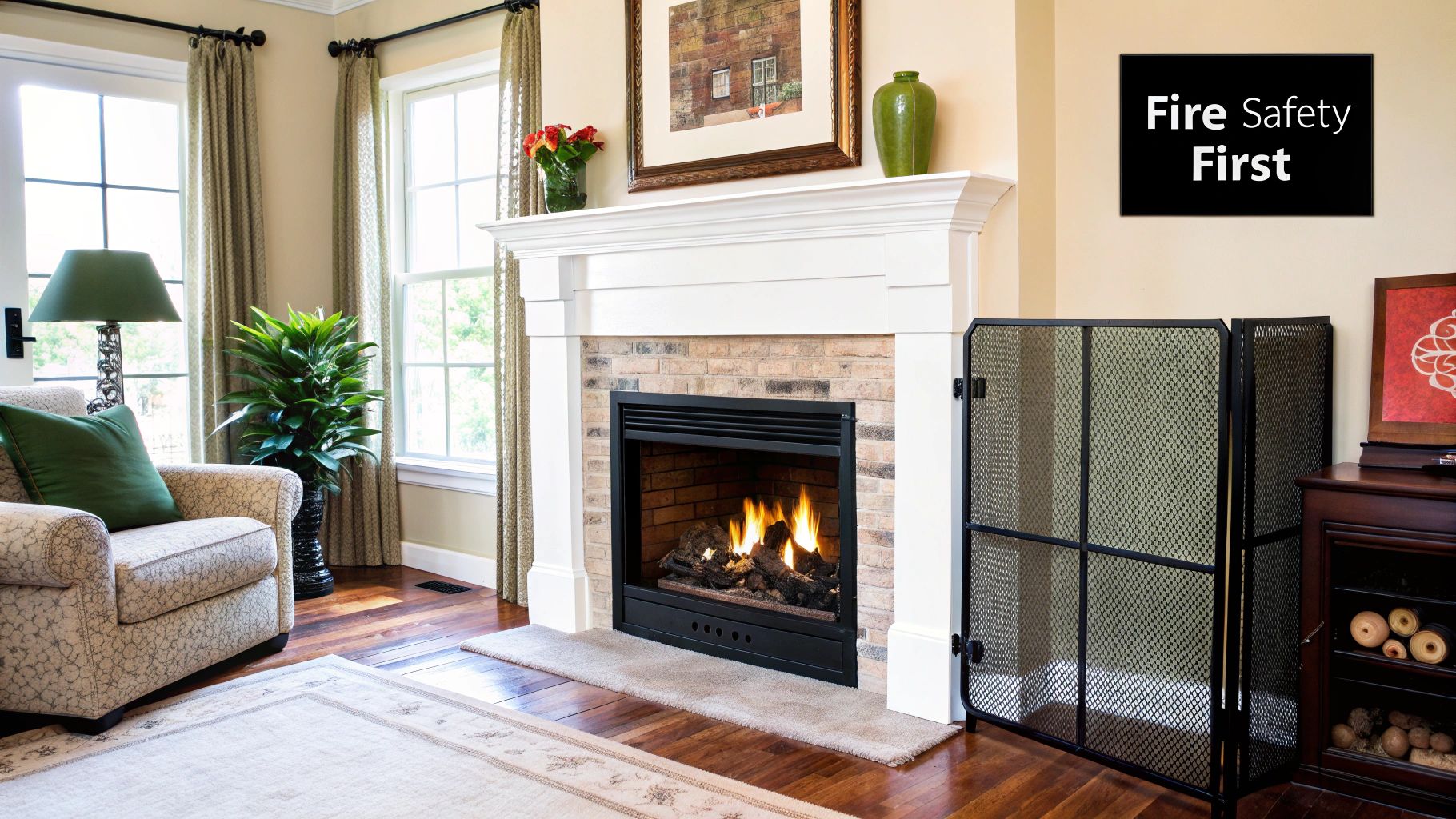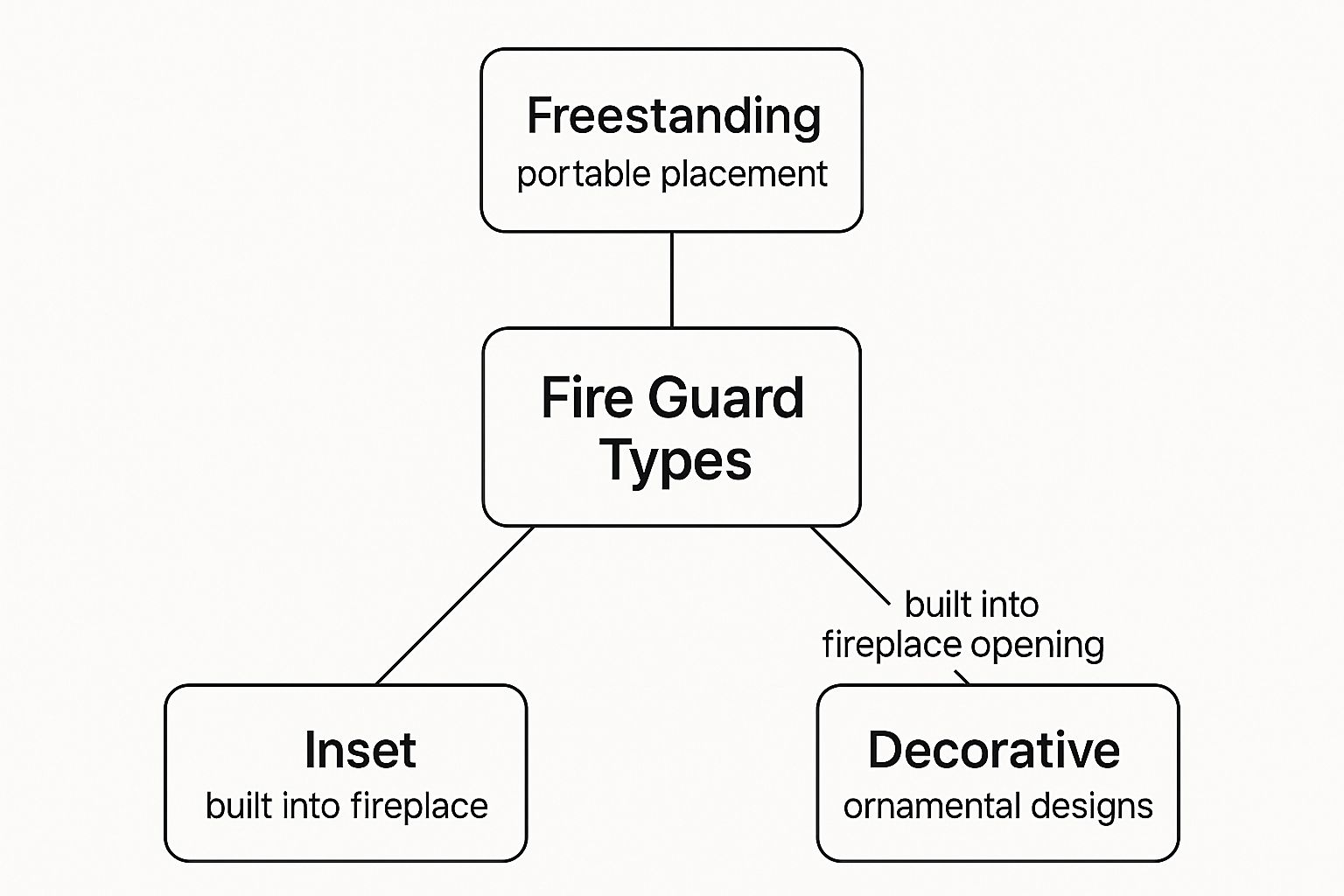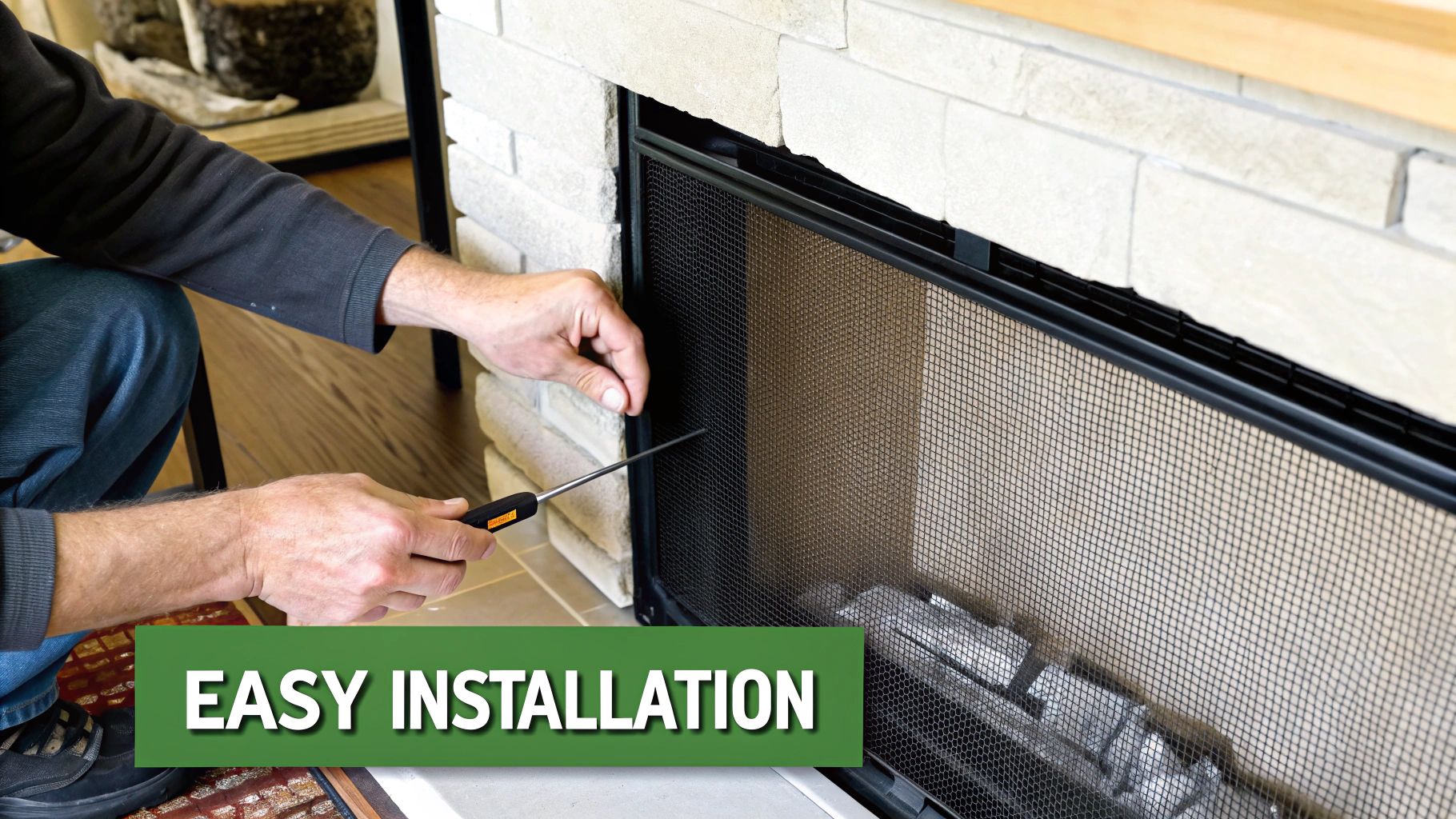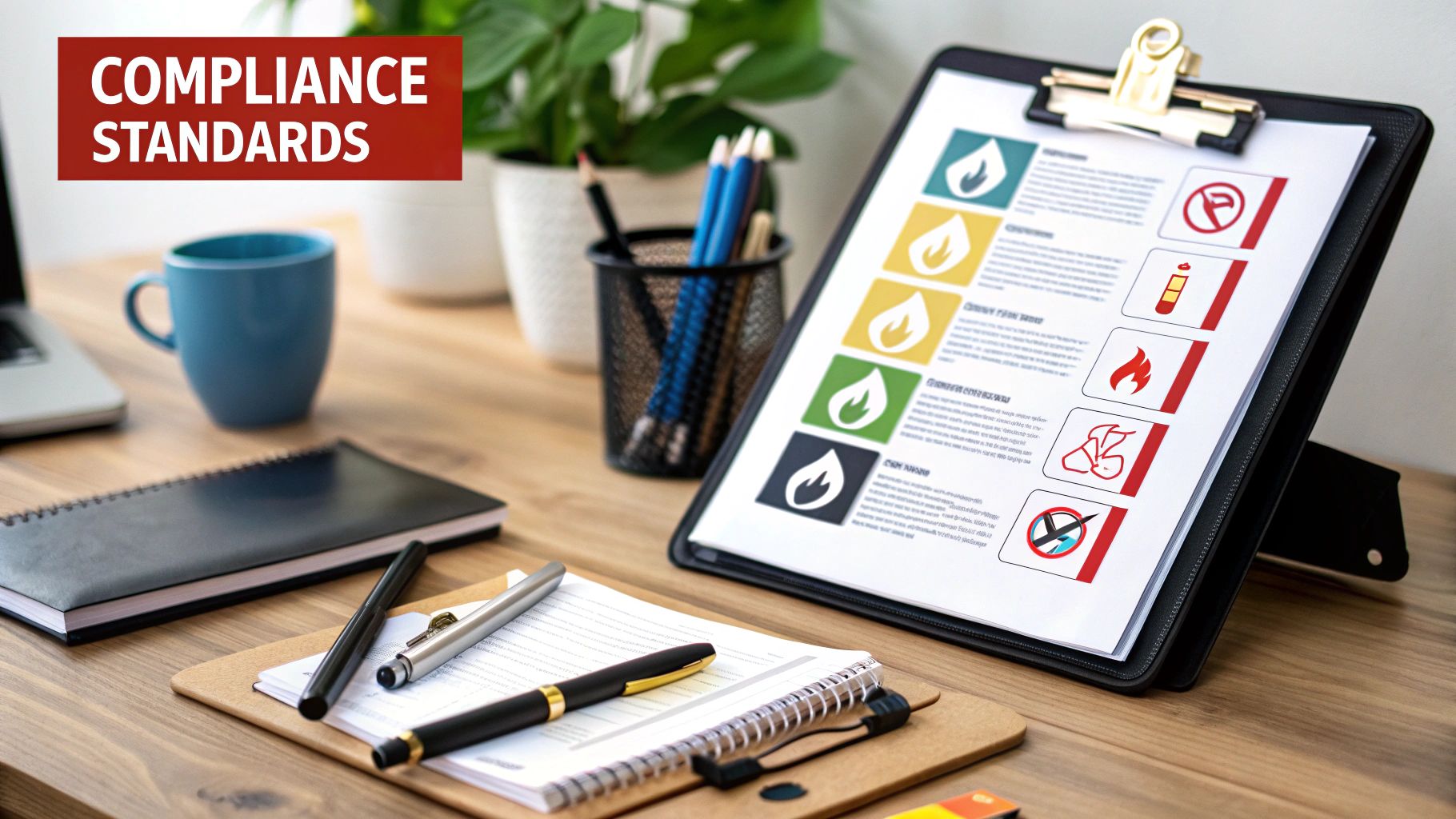In any Kiwi home with a fireplace, a high-quality fire guard is more than just an accessory; it's a vital piece of safety equipment. It provides a robust, physical barrier, carving out a non-negotiable safe zone to keep curious kids and pets away from the danger of severe burns. The right one brings genuine peace of mind.

Protecting Your Home With The Right Fire Guard
There's nothing quite like a warm fire to make a house feel like a home, but it’s a serious safety risk too. Whether you have a classic open fireplace or a modern freestanding log burner, the intense heat can cause nasty injuries in a split second. This is where the premium fire guards NZ families rely on become absolutely essential.
Think of a quality fire guard as a personal security guard for your hearth. Its main purpose is to create a safe perimeter, stopping anyone from accidentally touching the flames, hot glass, or scorching metal. This is especially important if you have young children, whose natural curiosity can easily lead them into harm's way.
More Than Just a Barrier
Sure, the primary job is safety, but the best fire guards are designed with both superior protection and real-world use in mind. They’re not just flimsy screens; they're properly engineered safety systems chosen from a wide range of quality products.
Here’s what you should be looking for in a top-tier product:
- Sturdy Construction: A quality guard is built from premium, heat-resistant materials, like powder-coated steel, that can handle high temperatures without bending or becoming a hazard themselves.
- Secure Design: Many leading models can be mounted directly to the wall or have heavy, weighted bases. This ensures they can't be tipped over by a determined toddler or a clumsy pet.
- Child-Proof Features: Look for cleverly engineered gate latches that are tricky for little hands to operate, and vertical bars that are tough for a child to climb.
A fire guard is a cornerstone of home fire safety. It works hand-in-hand with your smoke alarms and a clear escape plan to keep your family safe. It’s one of those simple, proactive steps that dramatically cuts down the risk of a preventable accident.
At the end of the day, selecting a high-quality fire guard is an investment in your family's safety. It lets you relax and enjoy the warmth and atmosphere of your fire without being on edge the whole time. To get a bigger picture of how to safeguard your home, it's well worth looking over a comprehensive home fire safety checklist, which perfectly complements having a good fire guard in place.
Choosing Your Ideal Fire Guard Type
With the extensive range of fire guards on the market, picking the right one can feel a bit overwhelming. But it doesn't have to be. The best way to narrow down the selection is to think about three things: your fireplace setup, who’s in your house, and your home’s style.
The golden rule is to match the guard to your heat source. What works for a classic open fire isn’t necessarily the right fit for a modern freestanding wood burner. Let's walk through the diverse range of types you’ll find here in NZ so you can make a confident choice.
This image gives a great overview of the main options and what they’re designed for.

As you can see, the product range is generally categorised by how they're set up—freestanding or fixed in place—and whether their main job is keeping people safe or just looking good.
Comparing Fire Guard Types and Their Uses
To make it even clearer, here’s a quick comparison of the common fire guard styles. This table should help you pinpoint which option from the available range best suits your fireplace or wood burner.
| Guard Type | Primary Purpose | Best For | Key Feature |
|---|---|---|---|
| Simple Spark Screen | Spark and ember control. | Open wood fires in homes without small children or pets. | Lightweight, single-panel mesh that stops sparks from damaging flooring. |
| Box Guard | Child and pet safety. | Freestanding wood burners or enclosing an entire hearth. | A sturdy, four-sided cage, often with a gate for easy access. |
| Multi-Panel Guard | Versatile child and pet safety. | Unconventional hearths, corner fireplaces, or creating a custom safe zone. | Hinged panels that can be angled to fit almost any space. |
Ultimately, your home's unique needs will guide your final decision, but understanding the quality and purpose of these core designs is the first step.
Simple Spark Screens
Let's start with the basics: the spark screen. This is usually a single panel of fine mesh designed to do one thing—catch any rogue embers or sparks that try to escape an open fire.
They’re brilliant at protecting your carpet or wooden floors from scorch marks. However, they're typically lightweight and not very stable, so they offer very little protection if you have curious toddlers or pets running around. A spark screen is best for homes where the main worry is just preventing property damage, not keeping little hands away from the flames.
Box and Multi-Panel Guards
When child safety is your top priority, you need to step up to a high-quality box guard or a multi-panel guard. There’s really no substitute for their robust design. A box guard creates a complete, secure perimeter around a freestanding wood burner or the entire hearth area. They’re built to be robust, stable, and often come with a built-in gate so you can still access the fire easily.
Multi-panel guards deliver the same level of safety but with more flexibility. They’re made up of several panels connected by strong hinges, which means you can shape them to fit awkward spaces like corner fireplaces or create a custom-sized "no-go zone."
For total peace of mind, always look for a box or multi-panel guard that can be securely fixed to the wall. This is a non-negotiable feature if you have young children, as it stops a determined toddler from pushing the guard over.
Material and Build Quality
The type of metal your fire guard is made from is just as crucial as its design. Most fire guards NZ suppliers will offer a range of models made from powder-coated steel or wrought iron, and both are excellent choices for different reasons.
- Powder-Coated Steel: This is the go-to material for most modern, high-quality guards. It’s strong, heat-resistant, and comes in a huge range of colours and styles to match your décor.
- Wrought Iron: If you want something with a bit more heft and a traditional, premium feel, wrought iron is fantastic. It’s much heavier, which adds a lot of stability, and the ornate designs can be a real feature.
Pay close attention to the overall build quality. You want to see strong, clean welds, hinges that move smoothly but feel secure, and a finish that can handle the heat without chipping away. If you've ever admired the solid construction of premium firepits and grills, you'll have a good idea of the durable, high-quality metalwork you should be looking for in a fire guard.
What to Look for When Buying a Fire Guard
A good fire guard is more than just a metal screen; it’s a critical piece of safety gear. When you’re choosing one from the wide range of products, it’s easy to get caught up in how it looks, but the real test is how well it protects your family. The trick is to find that sweet spot between rock-solid safety, durable construction, and a design that actually looks good in your home.

Before you start shopping, think about your own situation. The perfect fire guard for a family with adventurous toddlers is going to be worlds apart from one needed in a home with just adults. Let's dig into the essential features that set the best quality fire guards NZ has available from the ones that just won't cut it.
Start With Accurate Measurements
First things first: grab a tape measure. This is the one step you can't skip. A guard that doesn’t fit properly is a genuine safety risk, as it can leave dangerous gaps or be easily knocked over.
Your mission is to create a secure bubble around your fire. Here’s how to get the numbers right:
- Measure the Width: Get the full width of your fireplace opening or freestanding wood burner. You’ll want to add at least 15-20cm to each side. This ensures the guard sits a safe distance away and can’t be accidentally nudged into the flames.
- Measure the Height: Measure from the hearth to the top of the fireplace opening. The guard needs to be tall enough to stop anyone, especially little ones, from reaching over the top.
- Measure the Depth: For a freestanding burner, measure from the front of the unit outwards. A minimum distance of 40-50cm is a good rule of thumb, but always double-check the heater manufacturer's specific recommendations.
The most crucial measurement isn't the fireplace, but the distance from it. A fire guard has to be far enough away that its own surface doesn't become a burn hazard. This creates a true 'safe zone' and is the non-negotiable part of fireplace safety.
Material and Build Quality Matter
The materials and overall build quality are what determine a fire guard’s effectiveness and how long it will last. Flimsy materials can warp from the heat, and shoddy construction can fail right when you need it most.
Keep an eye out for guards made from heavy-duty steel. This gives it the strength and stability to handle accidental knocks and bumps without budging. The finish is just as important. A heat-resistant powder-coated finish is the standard for high-quality products for a reason—it stops the paint from chipping, peeling, or releasing nasty fumes when things heat up.
Prioritise Child-Proofing Features
If you have young children in the house, child-proofing isn't just a feature; it's the whole point. Toddlers are endlessly curious and surprisingly strong, so you need a guard that's built to withstand their explorations.
Here are the key child-proofing details to look for in the best quality guards:
- Secure Wall-Mounting System: The safest fire guards NZ families can buy are the ones that physically bolt to the wall. This makes it impossible for a child to pull or push the entire thing over.
- Complex Gate Latches: Look for a gate with a two-action opening mechanism that requires adult dexterity. A simple latch is a puzzle a determined toddler will solve in minutes.
- Vertical Bars: Guards with vertical bars are much harder for kids to climb than those with horizontal ones, which can act like a ladder. Also, make sure the bars are spaced closely enough that a small head can't get stuck.
While safety is always the number one priority, that doesn't mean you have to settle for something that looks like a cage. The modern range of high-quality guards includes sleek, minimalist designs that can enhance your living space. It’s a bit like how the best premium steel outdoor fireplaces blend powerful function with stunning design. Choosing the right fire guard ensures your fireplace remains a beautiful—and completely safe—centrepiece in your home.
How NZ Fire Safety Standards Evolved
The robust safety standards that protect Kiwi homes today, including those for fire guards, weren't created overnight. They've been shaped by over a century of hard-earned lessons, reflecting New Zealand's deep-rooted commitment to keeping people safe. Looking back at this history really puts into perspective why the product quality rules we have now are so critical.
The journey started with early laws focused on simply organising firefighting efforts. It was a slow and steady process, moving from a patchwork of local, independent brigades towards a single, coordinated national body.
From Local Boards to National Coordination
A major turning point came with the Fire Brigades Act of 1906. This legislation set up a system for local fire boards in any district with more than 2,000 people. These boards were funded by a mix of insurance companies, local councils, and the government, and they were in charge of their own fire brigades. To keep everyone honest, an Inspector of Fire Brigades was appointed to check on their performance.
Fast forward to 1949, and there were about 45 different fire boards running independently. As you can imagine, this created a lot of inefficiencies. This realisation led to the Fire Services Act of 1949, which established a central Fire Service Council.
This new council had a big job: coordinate all the urban fire authorities, standardise training, and manage budgets and equipment. It was a massive shift away from localised control toward a nationally coordinated strategy, which made a huge difference in how effectively we could prevent and respond to fires. For a closer look at this transition, the Department of Internal Affairs has a fantastic documented history of New Zealand's fire service.
This timeline shows a clear trend: as new risks emerged, our systems adapted to offer better, more consistent protection for everyone.
The evolution from scattered local fire boards to a centralised Fire Service Council mirrors the development of safety standards themselves. What began as localised common sense has evolved into a structured, evidence-based system that directly influences the design and quality of the fire guards NZ families use today.
This dedication to standardised safety isn't just about fire prevention, either. You see the same principle applied across many different areas to protect the public. For example, understanding how broad regulations like the joint Australian and New Zealand electrical standards (AS/NZS 3000) are developed and enforced shows how these frameworks operate for other essential services.
It's this wider regulatory environment that ensures all safety equipment, from your home’s wiring to the fire guard in your living room, meets a high, reliable standard. And that’s what gives homeowners real peace of mind.
Getting Installation and Maintenance Right
You can buy the best fire guard on the market, but it's only as good as its installation. A poorly fitted guard isn't just ineffective; it can actually become a hazard itself. Getting the setup right from day one, and keeping an eye on it over time, is what truly makes it a reliable safety feature for your home.

Think of it this way: a properly secured guard becomes an immovable part of your room, creating a solid barrier that curious kids and pets simply can't breach. Whether it’s a freestanding model that relies on clever positioning or a wall-mounted one that needs the right hardware, stability is everything.
Achieving a Rock-Solid Installation
When it comes to wall-mounted fire guards, you're aiming for a connection that can handle a surprising amount of force. That means choosing the right fixings for your specific wall type is non-negotiable.
- Drywall (Gib board): Whatever you do, don't just screw straight into the Gib. It won't hold. You'll need proper toggle bolts or heavy-duty wall anchors that expand behind the board, giving you a really secure grip.
- Brick or Concrete: This requires a bit more grunt. Use a masonry drill bit to make a pilot hole, then use dedicated masonry screws or expanding sleeve anchors to lock the brackets in tight.
- Wood Framing: This is the gold standard. If you can find the wooden studs in your wall, screwing directly into them gives you the strongest possible anchor point.
If you're even slightly unsure about doing this yourself, it's always smarter to call in a professional. There’s a list of approved installers in NZ who have the right tools and know-how to make sure it's done safely and correctly.
For freestanding guards, it's all about placement. Make sure it's sitting on a completely flat, level surface where it can't wobble or tip. Its own weight is designed to keep it stable, but it must be placed far enough from the fire that a determined toddler can't push it over and into the hearth.
When it comes to child safety, a correctly installed fire guard is a must. It should feel like a permanent fixture, with absolutely no movement or give when you push or pull on it. That stability is what prevents accidents.
Simple Checks for Lasting Safety
Once your guard is in, a little bit of ongoing care will keep it in prime condition. It’s easy to forget, but neglect can lead to rusty spots, weakened joints, or sticky latches, all of which compromise its integrity.
Just set a reminder to give it a quick once-over every few months. Here’s a simple checklist:
- Check Hinges and Latches: Swing the gate open and closed a few times. Does it move smoothly? Does the latch click securely into place? Any stiffness or looseness is a sign it needs attention.
- Inspect for Wear and Tear: Have a good look for any rust, cracked welds, or bent bars. Pay special attention to the feet and the points where it connects to the wall, as these areas take the most stress.
- Clean it Regularly: A quick wipe-down with a soft, damp cloth is all it takes. This stops dust and grime from building up, which can eventually damage the finish and lead to corrosion.
By following these straightforward installation and maintenance tips, you can be confident that your fire guard will remain a dependable safety tool, giving you complete peace of mind all winter long.
Got Questions? Here Are a Few Common Ones
Picking the right fire guard for your home often brings up a few specific questions. It's one thing to know the range of types available, but it's the practical details about product quality and suitability that really help you nail down the perfect choice. Let's walk through some of the most common queries we hear from Kiwi homeowners.
Getting these details right isn't just about ticking a box; it's about making sure your home stays the safe, warm haven it’s meant to be.
How Far Away From the Fire Should the Guard Be?
This is probably the most critical question we get, and the answer isn't one-size-fits-all—it really depends on your fire. The main goal is to create a 'safe zone' so the guard itself doesn't get dangerously hot.
For a classic open fire, a good rule of thumb is to keep the guard at least 75cm away. If you have a modern, enclosed wood burner, you can usually get a bit closer, maybe around 40-50cm. But here’s the most important part: always, always check the manufacturer's recommendations for both your heater and the fire guard. Their specs trump any general rule.
Are Mesh or Bar-Style Guards Safer for Kids?
Both are great options, but they tackle safety in slightly different ways. The best one for you often boils down to your kids' ages and the quality of the product you choose.
- Mesh Guards: These are your best friend for stopping sparks and spitting embers from an open fire. With a high-quality model, the mesh will be fine enough to prevent curious little fingers from poking through the small holes.
- Bar-Style Guards: These tend to feel sturdier and are harder for a determined toddler to push over. The key safety feature here is the gap between the bars. You need to be certain it’s too small for a child’s head or arm to get stuck.
Ultimately, the best child-proof features are the same for both styles. You want a high-quality product that is tall enough that they can't climb it, a model that can be securely fixed to the wall, and a gate with a child-proof latch that needs two separate actions to open.
Can I Just Use a Pet Gate Instead?
No, absolutely not. It's a common thought, but it's an incredibly dangerous mistake to make. A standard pet or baby gate should never, ever be used in front of a fire.
Those gates simply aren't made from quality materials designed to handle heat. The plastic components, paint, and even the metal can melt, warp, or give off toxic fumes when exposed to the intense radiant heat from a fireplace.
Always use a product that is specifically designed and sold as a fire guard. They are built from the right stuff, like powder-coated steel, with finishes that can handle high temperatures without breaking down or becoming a hazard in their own right.
What's the Best Guard for an Awkward-Shaped Hearth?
Got a tricky corner fireplace, a raised hearth, or some other unique design? Don't worry, there's an extensive range of solutions for that. What you need is a configurable, multi-panel fire guard.
These are made up of several panels connected by flexible hinges, so you can bend and shape the guard to fit just about any space perfectly. Most come with a set number of panels (like five or seven), but good suppliers will sell extra extension panels so you can build a barrier as large or as customised as you need. For any multi-panel setup, the key to stability is making sure you can securely mount both ends to the wall.
At Apollo NZ, we’ve hand-picked a range of high-quality fire guards that meet the tough safety standards needed in New Zealand homes. Our collection features versatile and sturdy options for any hearth, so you can keep your family safe without giving up on style. See our solutions and find the perfect fire guard for your home at https://www.apollonz.org.
Article created using Outrank



